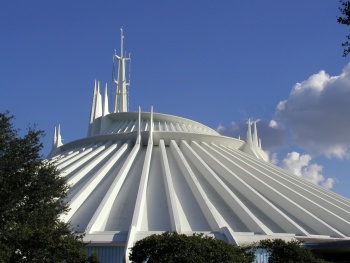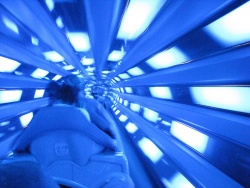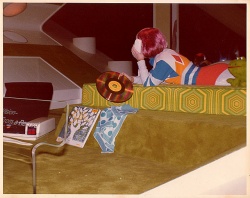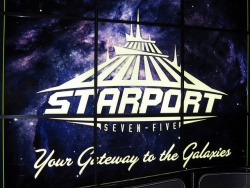Space Mountain
Space Mountain is an attraction located in Tomorrowland.
Contents
Attraction History
The idea for Space Mountain came from Walt Disney himself. After the successes of the Matterhorn attraction in Disneyland, Walt was convinced that "thrill-rides" had a place in his park. With this in mind, in 1964 Walt approached designer John Hench with an idea for a new Tomorrowland attraction. Walt called the idea the "Space Port", a roller coaster in the dark that would feature lighting and other special effects.
Concept art for the attraction was created by Hench, Clem Hall, George Mcginnis and Herb Ryman. The attraction's name was changed to "Space Voyage", and ideas for it continued to be refined. To help make the attraction a reality, WED partnered with the Arrow Development Company, who had helped design the Matterhorn. In June of 1966 WED employees voted, and decided to change the name to Space Mountain.
Plans for Space Mountain were put on hold indefinably in 1966. After Walt Disney's death, a new company wide focus was put on completing Walt Disney World. This, combined with the spacial and technological limitations of Disneyland made the construction of Space Mountain unfeasible.
Although the Space Mountain idea was dead in Disneyland, it soon found life in the newly constructed Walt Disney World. The popularity of the new park surpassed even Disney's expectations, and the new park proved to be extremely popular with teenagers and young adults. Almost as soon as the park opened plans were made for a new thrill ride.
Although Disney's first choice was a version of the Matterhorn, Walt Disney World's Fantasyland was not big enough to house the attraction. It was decided however, that Disney World's Tomorrowland would be big enough to house the tabled Space Mountain idea. With this in mind, Imagineers back to work on the development of the coaster. It was decided that instead of using the Arrow Development Company and their track ideas, Disney Imagineers would design the track themselves. The idea they came up with was to make the coaster a "pure gravity" ride. This meant that Space Mountain features no boosters or retarders.
One of the major contributing factors to the creation of Space Mountain was sponsorship. Disney gave RCA the opportunity to sponsor the attraction, which the chose to do. RCA payed 10 million dollars to help built Space Mountain. Because of this sponsorship the queue and post show were designed to feature RCA products.
The final design of the Space Mountain changed many times before the attraction was eventually built. The Designs the interior structure, queue and post show all changed various times before Space Mountain was built, The shape of Space Mountain was also a topic of debate amongst Disney Engineers. Some of the engineers wanted Space Mountain to look like a dome, while others wanted to use a "cone" shape. The cone shape idea eventually won out, and on January 15, 1975 Space Mountain officially opened.
Building Structure and Track Details
When Space Mountain was built it was a technological marvel. The attraction was the first indoor roller coaster and also the first roller coaster to take place completely in the dark.
Space Mountain also has the distinction of being one of the largest buildings in Walt Disney World. At 183 feet tall, Space Mountain is just 6 feet shorter than Cinderella's Castle. The supports for Space Mountain are also unique, in that they are located on the outside of the building instead of the inside. This was done so that the inside roof would be flat, and projections would be able to be shown on it.
To create the illusion of stars above the riders, 20 mirrored balls are hit with a spotlight. When the light that reflects off the balls hits the roof, and gives the allusion of stars. Other projections include The "shooting stars" which are created by a moving spotlight, and the asteroids and galaxies which are created by dimmed down projectors.
Space Mountain has a total area of nearly In total the construction of Space Mountain required 4,000 pieces of steel, and 12,000 feet of electrical wire. Since every piece of steel had to be accessible by stairs, the inside of Space Mountain resembles a metallic maze.
Original Attraction Plot Attraction Plot
Space Mountain is a roller coaster that allows guests to travel through space.
Preshow
From 1973 until 1994 Space Mountain was sponsored by RCA. Guests entered Space Mountain through an entrance building located in Tomorrowland. The Building had three large RCA logos as well as a original "four seat" ride vehicle encased in a clear case. Inside the vehicle sat a family. Before guests entered the "entrance portal", they would pass a large quote on the wall which read:
"ONE GIANT STEP... Dedicated to the men and women whose skills, sacrifice, courage and teamwork opened the door to the exploration of man's exciting new frontier...outer space. Because they dared to reach for the stars and the planets, man's knowledge of his universe, earth and himself has been greatly enriched. Presented by missile, space and range pioneers. January 15, 1975."
Just after entering the building, guests boarded a descending moving ramp. On the right side of the ramp, guests could see RCA's logo, Nipper the Fox Terrier inside a flying saucer. At this point in the attraction RCA's Space Mountain theme song- "Here's To The Future And You" began to play. Further down the ramp guests could look out convex windows and see the Star Corridors, a series different space themed displays. One display for example, showed an astronaut riding his moon buggy in space.
On the left hand side of the decention ramp, a series of RCA products were displayed. The reason for the descending ramp, was to take guests underneath the Walt Disney Railroad to the lot where Space Mountain is actually located.
After guests finished descending, they reached the "zig zag corridor". Here windows allowed guests to see out into space. Things that could be seen out the windows included:
- Astronauts fixing a satellite
- Galaxies
- Planets
- Shooting Stars
- And finally, a family riding the Space Mountain ride vehicle in space.
After passing through the Zig Zag Corridor, guests finally reached the loading area. Here they watched a safety video featuring Astronauts Gordon Cooper and then boarded either the Alpha or Omega track. Both of these tracks were identical except for the fact that Alpha track is ten feet longer.
Ride
Space Mountain begins with guests boarding their "rockets". The rockets then take off passing the Space Port queue and the Mission Control booth. The jets the go up a lift hill and down a small slope. This leads to a circular tunnel lined with blue lights. Here energy can be building up, and eventually propelling guests to the other end of the dome. Here, the rockets do a 180 degree turn and go up another lift hill. A mirror positioned at the end of the track, gives riders the allusion that they are about to collide with another rocket. If riders look up, they are able to see projections of Earth, stars, comets, meteors, and asteroids above them. This adds to the feeling that the rockets are indeed flying through space.
As the rockets continue on, they go down a quick dip and then a series of twists and turns. At this point in the attraction, the ride is taking place in almost complete darkness. In the dark, guests then fall down a 38 degree drop, the steepest in the attraction. Space Mountain ends with guests passing through a red, swirling wormhole before reaching the unloading area.
RCA's Home of Future Living
From 1973 until about 1985 Space's Mountains post show was known as the RCA Future Living. After unloading from their ride vehicles. guests board another moving ramp which took them up. On the right side of the ramp was guests began to see scenes of how future homes would look. The first scene depicted a father wearing a blue jumpsuit and lounging in his hair. In front of him was a TV the size of a briefcase which showed a female business associate of his. The man was able to conduct his business meeting while in the comfort of his own home. Continuing on guests saw a model of the house. All of the houses were shaped like hexagons, and each room was connected by stairways.
The next room that guests saw was the nursery. Here, while a baby stood in her crib, a clown with a camera was broadcasting her to the rest of the house. This allowed the parents to keep an eye on their baby even though they were not in the same room. Continuing on, guests passed the family room. Here a unidentified female could be seen taking a pottery lesson over her TV. She was able to talk and communicate with her professor who was being displayed. The next scene, showed a boy named Billy who was wearing an orange jumpsuit. He was standing outside of his house with a frog and a dog. Billy would talk into a camera on the outside of the house saying "Don't you like frogs Mrs. Brown?". The mother would then tell Billy that he would have to stay outside.
Going back inside the house, guests could see the recreation room. This room was located above the family room. Here a boy could be seen talking a ski lesson from the SelctaVision, while his younger brother built a model rocket using instructions from the TV. Next tot the recreation room was the kitchen. Where the mother of the house, and a neighbor sat in front of a large TV. In this room, the mother was shopping for dishes directly on the TV. In the corner of her TV screen, Billy could be seen, still pleading to come in. Moving on, guests would come across the teenage daughter's room. Here a teenager was watching a classic SelctaVision disc. While she was doing this she was on the phone with Judy, who she would always tell to come over. The final room of the house, was the entertainment room. This room housed the biggest TV in the post show, which was being watched by a young girl and boy.
After viewing the home of the future, guests would see various RCA products as the attractions theme song played again. Before exiting guests would get one final encounter with Billy, who was now holding a video camera and pointing it at the guests. A TV would show guests themselves (this was considered one of the highlights of the attraction). Finally, guests would arrive back in Tomorrowland having completed their journey into space.
Pre and Post Show Changes 1985-2009
In 1985 RCA replaced the "Home of the Future" post show. The new post show showed what it would be like to live on a space colony. Billy and his dog, who once recorded gusts and put them on TV, were replaced with a robot boy and a robot dog. The TV monitors that once advertised RCA, were changed to show astronauts in space. Although the story of the post show changed, its main purpose was once again to show RCA television.
In 1994 Fed Ex took over sponsorship of Space Mountain, and the attraction went through many changes. In 1994 the entrance door received storm shutters, making the entrance much smaller. The left hand entrance wall, which had previously been used for signage was demolished. The right hand entrance wall had only the words, Space Mountain written on it. Space Mountain was written in orange thin ink, representing the "New Tomorrowland". On the outside of the entrance, the spiral which had once read "RCA" was removed. A new spiral which had signs for both Space Mountain (once again written in the orange font) and Fed Ex was added.
The entrance lobby was also given a makeover. It was given an orange and brown color scheme, and a large mural of the Milky Way was added. In 1998, the original flooring was removed and a staircase was added to the right hand queue.
With the new sponsorship, parts of the the preshow were changed or taken out completely. The windows that guests could previously look out and see various scenes from space were removed and were left empty for a number of years. The flying saucer which once held the RCA dog and a phonograph was also taken out (for obvious reasons).
Although Fed Ex did not change much of the post show's props, it did change the story they told. Instead of focusing on a space colony, and the technology that could be used there, Fed Ex focused on the future of package delivery. The new post show showed how one day packages could be sent over spacial distances. "Space packages" were also added to the post show, to further promote Fed Ex.
Another major change that came with the 1994 refurbishment was the removal of the entrance building. Now when guests exit Space Mountain, they come out in the Tomorrowland Arcade. In 2004 Fed Ex decided to end its sponsorship of Space Mountain, leaving the attraction sponsorless.
Current Attraction
In 2009 Space Mountain underwent a major refurbishment. Changes were made to the preshow, ride and postshow.
Preshow
When Space Mountain reopened in 2009, various video games were added to the preshow. The games were added to the stand-by line in order to make the waits more manageable. In total, 43 videos games were added. Space Mountain queue included new warnings signs, a new warning spiel, and a return to classic color scheme of the attraction. The windows that had once shown space scenes, now allowed guests to look out into space itself.
Guests may also notice a large mural consisting of different panels. The Mural reads, "Starport 75", a reference to the year the Magic Kingdom opened. It seems that in the new backstory, at least the preshow, if all of Space Mountain is actually a Starport.
The Alpha track is now primarily used for stand-by guests, while the Omega Track is for Fastpass guests. If the line is short (less then 20 minutes), it is possible for stand-by guests to ride the Omega track. After dividing up, guests enter the loading area. The ceiling to the loading area is open, allowing guests to look into space before getting into their ride vehicles.
Ride
Although the ride is similar to the original version, their have been some changes. The ride still begins with the rockets leaving the loading area, instantly making a 180 degree turn. After taking the turn the rockets come to a stop in a purple tunnel, right before a lift hill. After climbing up the hill the vehicles fall down a slope into the blue strobe tunnel. The tunnel is similar to its previous incarnation, however the lights now flash with increasing speed, as the energy builds up. Also of note, an on ride photo camera has been added to the tunnel, allowing guests to purchase on ride photos after the exit. The vehicles continue on towards a blue orb at the end of the tunnel. For a moment, the blue lights shut off allowing guests to see the stars all around them.
After exiting the tunnel, the rockets go up another large lift hill. While going up it is possible to see other rockets, as well as riders on the Tomorrowland Transit Authority PeopleMover. After reaching the top of the hill, riders go down a steep drop followed by a series of twists and turns. Like before, it is possible to see various space objects above the track. The vehicles then go down the biggest drop (still at 38 degrees). They then enter the red wormhole and hit the final brake run, before reaching the unloading area.
Postshow
The new postshow begins with on guests left hand side. Here a robot is show manning a station known as the MK-1 Command Center. He is apparently in charge of what guests see in the post show. Moving onto the escalator belt, guests come across three scenes from space. The first two, are known as the Mercury Peak and the Crater Caverns. These scenes are similar, albeit redesigned versions, of the previous post show. Anything related to Fed Ex has been removed. The third scene, is a new scene known as "20,000 Lightyears Under the Sea". This scene closely resembles the underwater scene on the former Epcot attraction Horizons.
After passing by the three scenes, guests come upon a futuristic kitchen. The kitchen features a circular round booth and a robot who is serving drinks. The next scene shows the outside of a futuristic town, with only blue light emitting from it. Both of these scenes show "the future that never was", the general concept of Tomorrowland.



